14 Outdoor Flooring Options – Ultimate Guide
Every patio needs outdoor flooring. But there are so many options that it can easily become overwhelming. Our ultimate guide walks you through 14 of the best outdoor flooring options, from concrete and brick to peel and stick tiles. We’ll go over the pros and cons of each type of outdoor flooring to help you decide which is best for you.
Poured Concrete
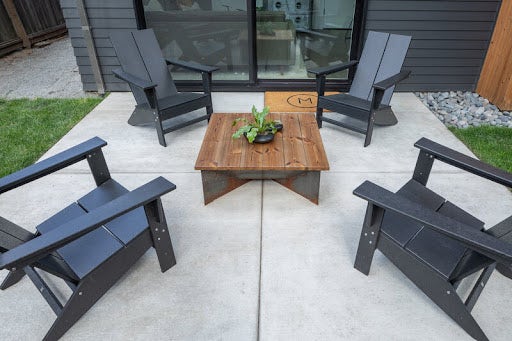
Poured concrete is an affordable and durable option for outdoor flooring. It’s laid out in long slabs, unlike pavers which are small pieces that come in different shapes and sizes. They are poured and cured on site. Before it cures, you can stamp wet concrete with a pattern, which is called stamped concrete. This gives your outdoor patio a unique look.
Over time, poured concrete slabs may buckle and crack. Maintaining them can be quite a chore. But they cost less up front than concrete pavers, which we’ll go over next.
Mục Lục
Poured Concrete Pros
- Cost-effective
- Durable – can last a lifetime
- Water, fire, and corrosion resistant
- Easy to clean
- Can be stamped for versatile designs
- Low maintenance
- Slip and stain-resistant
- Contains no VOCs
Poured Concrete Cons
- Difficult to repair if cracked
- The hard surface can be uncomfortable
- Cold to walk on
- Prone to mold and mildew if not cured and sealed properly
- Noisy to walk on
Is it cheaper to lay pavers or poured concrete?
The upfront cost of poured concrete is cheaper than pavers. But pavers are easier to repair, more durable, and not prone to cracking like poured concrete. So they are a better long-term investment in most situations than poured concrete.
Concrete Pavers

Concrete pavers are a modern and ultra-durable outdoor flooring option for your patio. They are common in today’s outdoor patios. They come in many different sizes and styles so you can customize your outdoor patio exactly how you want. Unlike poured concrete, pavers are pre made so they are not poured on site. This makes installation much easier. Repairs are often simpler too. With pavers, you can replace individual tiles that are damaged or cracked. This makes maintenance quick and easy.
Concrete Pavers Pros
- Variety of sizes and styles
- Can easily repair individual damaged tiles
- More durable than poured concrete
- Easy to install
- Doesn’t need to cure
- Slip and stain-resistant
- Water, fire, and corrosion resistant
- Contains no VOCs
- Adds curb appeal
Concrete Pavers Cons
- Need additional pavers for repairs
- Prone to cracking from roots
- Can become crowded with weeds
- Requires a base
- Can become uneven over time
Which is better, concrete or pavers for a patio?
In terms of durability and looks, concrete pavers are your best option. Although the upfront cost of poured concrete is cheaper than pavers, you’ll get more value out of pavers. It’s easy to replace individual pavers if they get damaged.
Concrete pavers are also better for high-traffic areas because they can handle more pressure per square inch than concrete. If you have heavy outdoor furniture, concrete pavers are the way to go.
Brick Pavers
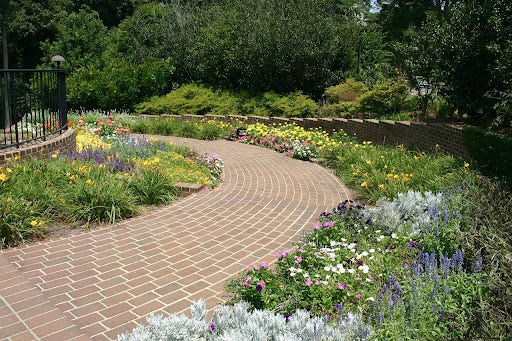
Brick outdoor flooring is a rustic, traditional choice for your outdoor patio. It can compliment an old-fashioned brick fireplace or pizza oven beautifully. Brick pavers aren’t as popular as concrete, but they’re perfect if you’re after a rustic look. Not to mention they are exceptionally durable.
Brick Pavers Pros
- Cost-effective
- Durable – can last a lifetime
- Low maintenance
- Slip-resistant
- Environmentally friendly
- Retains heat well
Brick Pavers Cons
- Difficult to repair or replace
- Limited design choices
- Hard surface that can be uncomfortable
- Retains water which can lead to mold or mildew
- Becomes uneven over time due to wear and tear
What do you put down under brick pavers?
Dirt or a sand and gravel composite are two practical options for a paver base. Use about one inch of sand for the most stable base. You don’t always need a base, but it’s recommended if your patio is uneven. An even foundation will keep your brick pavers in great condition for years.
Porcelain

Porcelain is an excellent outdoor flooring option that gives your patio a modern look. Porcelain is clay fired at over 1200º F, making it exceptionally durable. As far as installation goes. It’s not as heavy as stone, concrete, or brick. But it is difficult to cut without professional equipment. If you’re looking for a more high-end option, porcelain is the way to go. Keep in mind that it’s not the cheapest option for outdoor flooring. If you need to save money, go with concrete outdoor flooring instead.
Porcelain Pros
- Weather, stain, mold, and water-resistant
- Not slippery
- Low maintenance
- Incredibly durable
- Easy to clean
- Several styles and colors to choose from
- Lighter than concrete and stone
Porcelain Cons
- Heavier than other ceramic outdoor flooring
- More expensive than other ceramic outdoor flooring
- Requires special equipment to cut tiles
- Requires a professional to install
Is porcelain tile good for outdoor use?
Porcelain is one of the most durable ceramic outdoor flooring options on the market. They are a more modern option than natural stone or brick and are easy to maintain. Porcelain does not require a sealant like most natural stone flooring.
Ceramic

Ceramic outdoor flooring is a more affordable, less durable alternative to porcelain. Ceramic is made from less refined materials compared to porcelain. It’s more porous and not as dense. Since it’s not as dense, it’s much easier to cut. This makes it a popular choice for avid DIYers. But it’s also not as durable.
Ceramic and porcelain are two of the most popular tile options for outdoor flooring. Consider your design preferences and budget when choosing between the two.
Ceramic Pros
- Cost-effective
- Durable
- Variety of colors and styles available
- Can be DIYed
- Easy to clean
Ceramic Cons
- Prone to cracking
- Not very weather resistant
- Porous, prone to water damage and mold
Is ceramic flooring waterproof?
Most ceramic tiles are water-resistant, not waterproof. It still works well for use in moisture-heavy areas like bathrooms, but porcelain is ideal in those areas.
Composite Wood Decking
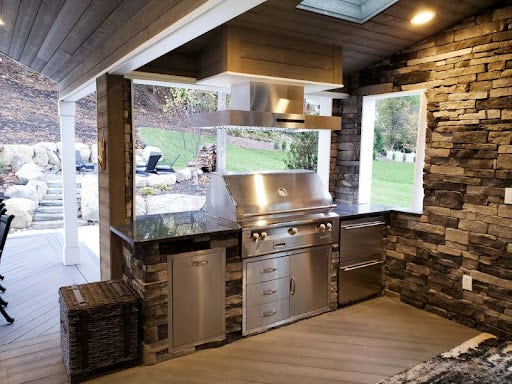
Composite deck outdoor flooring is one of the most reliable outdoor patio flooring options. It’s durable, easy to clean, weather-resistant, and eco-friendly. Composite materials sometimes get a bad reputation because they are not the real thing. But the fact that composite decking is so durable and low maintenance has attracted homeowners. Composite deck tiles make the outdoor flooring easy to install too.
Composite Wood Decking Pros
- Incredibly durable
- Low maintenance
- Eco friendly
- Many color options
- Straightforward to install
- Weather, stain, mold, and water-resistant
- Doesn’t splinter or rot like natural wood decking
Composite Wood Decking Cons
- Not natural wood
- More expensive than real wood
Is it cheaper to build a wood deck or composite deck?
A composite deck can be up to twice as expensive as a wood deck. But composite decks are much more durable, water-resistant, and easy to maintain than traditional wood decks. In the long run, you’ll spend more money maintaining your wood deck.
Traditional Wood Decking

Traditional wood decking is one of the most inexpensive outdoor wood flooring options, depending on the type you choose. Pine is the least expensive, but there are a wide variety of wood decking materials to choose from. They have varying durability and looks, so you have some flexibility. Cedar is a more expensive, but durable and popular, wood decking option.
If you love the look of natural wood, this is the option for you. Just be aware that this type of deck requires more maintenance than composite decking.
Traditional Wood Decking Pros
- Easy to install
- Affordable
- Rustic natural wood look
- Variety of wood decking materials to choose from
Traditional Wood Decking Cons
- Requires consistent maintenance – cleaning, polishing, and staining
- Needs to be pressure treated
- Not very weather resistant
- Not very durable
How long does a traditional wood deck last?
Most traditional wood decks last about 10 to 15 years. If you keep up with the maintenance consistently you may be able to get a few more years out of your wood deck. The quality of wood impacts the durability too. Pressure-treated pine is less durable than cedar and redwood.
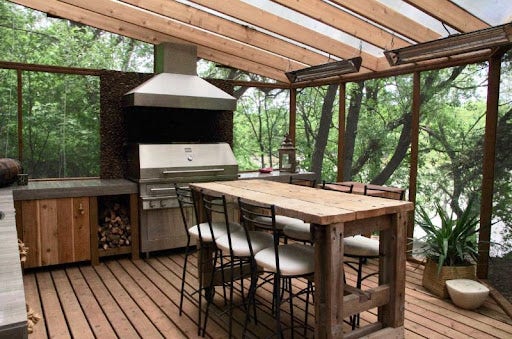
Artificial Grass

Artificial grass is one of the least popular outdoor patio flooring options. But it’s quick and easy to install and requires virtually no maintenance. The main downside is you don’t get the natural look of real grass. You might choose artificial grass if you:
- Need a quick and easy outdoor flooring option
- Want to cover up some unsightly concrete
- Don’t have time to maintain your outdoor patio consistently
Artificial Grass Pros
- Durable
- Low maintenance
- Vibrant green color
- Cost-effective
- Easy to install and replace
Artificial Grass Cons
- Doesn’t look natural like real grass
- Not as long-lasting as natural grass
- Limited design choices
- Can’t grow plants or trees on the turf
Can you put artificial grass on concrete?
Yes, concrete is a great base for artificial grass. A wood base or crushed rock are two alternatives if you don’t want to pour a concrete base. If you already have concrete though, then you’re all set.
Rubber Tiles

Rubber might not be the first material you think of when you’re researching outdoor patio flooring. But it’s surprisingly durable, features plenty of design options, and is quick to install. Rubber outdoor flooring is installed in pieces, so if one gets damaged, it’s easy to replace. You might pay a little more for rubber than your standard wood or concrete outdoor floor. But often the extra investment is worth it!
Rubber Tiles Pros
- Easy to install
- Durable
- Many color and style options
- Water-resistant and heat-resistant
- Slip-resistant
- Easy to replace if damaged
- Low maintenance
Rubber Tiles Cons
- Expensive
- Doesn’t look natural
Are rubber tiles good for outdoors?
Yes, rubber tiles are incredibly durable and easy to maintain. They also stay much cooler than concrete and are comfortable to walk on.
Natural Stone Pavers

Natural stone pavers are a beautiful outdoor flooring option. They are more high end than brick flooring or concrete pavers, but offer beautiful design and great longevity. Stone pavers require a flat base for the best installation, like sand or concrete. This can take some time to prepare. But they are long lasting and low maintenance, so you get your money’s worth.
Natural Stone Pavers Pros
- Easy to install
- Many different colors and styles
- Environmentally friendly
- Weather-resistant and water-resistant
- Can be individually replaced
- Durable
Natural Stone Pavers Cons
- Hard surface that can be uncomfortable
- Requires a flat surface for installation
- More expensive than concrete or brick pavers
Can natural stone be used outside?
Yes, natural stone is a great option for your outdoor flooring. It’s exceptionally durable. The earthy colors blend in perfectly with the outdoor environment. As the name suggests, the stones are natural. That means they are non-toxic and environmentally friendly!
Vinyl Tiles

Vinyl tiles are easy to install and durable. Vinyl is made of durable synthetic material that is water-resistant and easy to clean. It won’t look as natural as brick flooring or stone but it’s a great option if you like the look!
Vinyl Tiles Pros
- Stain and scratch-resistant
- Durable
- Can imitate natural hardwood
- Easy to clean
- Water and weather-resistant
- Comes in sheets or planks
Vinyl Tiles Cons
- Must be installed in enclosed or covered outdoor patios
- Not ideal in high traffic areas
- Can’t support heavy weight
- May contain VOCs
Can you use vinyl flooring outside?
Yes, but it’s best to install vinyl floors in an enclosed temperature-controlled patio. Vinyl floors can expand or contract when they come into contact with extreme temperatures. Consult the manufacturer’s instructions to ensure your vinyl flooring is built for outdoor use.
Is outdoor vinyl waterproof?
Yes, outdoor vinyl flooring is waterproof. It’s a fantastic alternative to hardwood or brick, both which are prone to water damage and mold growth.
Peel and Stick Tiles

Peel and stick tile is a versatile and affordable outdoor flooring option for your patio. You have countless design options to customize your outdoor space. Peel and stick tile doesn’t involve the hassle of cutting tile with a tile saw. It’s a great option for beginner DIYers.
Peel and stick tile is also less expensive than real tile. It requires a steady hand, though. If you don’t align your tile correctly the first time, it’ll be difficult to remove it.
Peel and Stick Tiles Pros
- Inexpensive
- Many style and color options
- Easy to install
- Little to no mess
- Can install over existing tile
Peel and Stick Tiles Cons
- Requires a steady hand
- Not very water-resistant
- Not modern
- Must properly prep the surface
- Adhesive wears down over time
Can you use peel and stick tiles outside?
Yes, but they often don’t look as real as traditional materials like vinyl or laminate. Peel and stick tiles can buckle and lose their shape over time, especially when in contact with harsh weather.
Can you put peel and stick tiles on concrete?
Yes, concrete is a great surface for peel and stick tiles. As long as the base is even with no gaps, you will have no problem installing them over concrete. Make sure that you stick the tiles on properly the first time, though. It will be difficult to remove the adhesive from concrete.
How long do peel and stick tiles last?
Peel and stick tiles can last anywhere from a few years to a few decades. In high traffic areas, they will not last as long. Or if your tiles come into contact with water often, they’ll wear down faster.
Are stick on tiles waterproof?
Most peel-and-stick tiles are waterproof. But water can still seep in between the tiles, since there’s no grout. This will decrease the longevity of your tiles. You can use a sealant to help keep water out.
Laminate Outdoor Flooring

Laminate outdoor flooring is one of the easiest types to install. It’s installed over a foam pad or flooring called an underlayment. The tiles aren’t glued down but instead installed on top of the foam pad.
Laminate is a durable composite flooring that can last decades. It is a composite material that’s made up of three layers: a plastic top layer, an image layer that makes the floor look realistic, and a bottom durable wood composite layer. For outdoor use, it’s important to seek out waterproof flooring.
Laminate Outdoor Flooring Pros
- Scratch and slip-resistant
- Easy to install
- Inexpensive
- Easy to clean
Laminate Outdoor Flooring Cons
- Not very water-resistant
- Chips easily
- Contains VOCs
- Requires a stable subfloor
- Can’t be refinished – will eventually require replacement
Can you use waterproof laminate flooring outside?
Yes, as long as your laminate flooring is waterproof and weather resistant, you should be fine. The bottom layer of laminate flooring is wood so it’s typically not waterproof. Just look for laminate floors specifically designed for outdoor use.
How long will laminate flooring last outside?
Outdoor-approved laminate flooring can last up to 25 years on your outdoor patio. In high traffic areas, it’ll last about 10 years. Most laminate flooring is manufactured for indoor use.
Pea Gravel
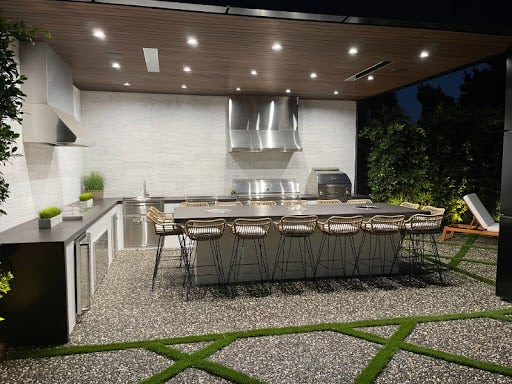
Pea gravel is a unique option for your outdoor patio. It’s not glued down, poured, or installed in sheets like other flooring options on this list. Pea gravel is easy to clean and isn’t prone to cracking. It will require refilling every few years though.
Over time, gravel tends to move around and track into your home or yard. But, with a porous floor, gravel drains easily. You don’t have to worry about puddles or water damage.
Pea Gravel Pros
- Easy to clean
- Great drainage
- Prevents weeds from growing
- Affordable
- Won’t crack or buckle like other outdoor floors
- Comfortable to walk on
Pea Gravel Cons
- Uneven surface
- Requires consistent maintenance
- Gravel moves and spreads easily
- Difficult to de-ice
- Requires refilling every few years
Can I use pea gravel as a patio base?
Pea gravel is not the ideal material for a patio base. Most pea gravel is about ⅛” to ¼” thick, which is a little small for a patio base. Typically, gravel for patio bases is ¾” thick. Pea gravel won’t compact as tightly which means it may shift over time.
Best Outdoor Flooring for Deck
For your deck, you have two options: traditional or composite wood decking. Both types are easy to install and affordable. Composite decking is easier to clean and maintain than traditional decking. It is also more durable and weather resistant. The main downside to composite outdoor flooring is that you don’t get the look of real wood.
Best Outdoor Flooring Material for Snow
Porcelain or slate pavers stand up well to cold temperatures. Concrete and brick flooring are more porous which can lead to cracks over time. But quality concrete and brick pavers are a safe option as well. Check out the manufacturer’s instructions to confirm that your outdoor material is safe in cold climates.
Best Outdoor Flooring for a Balcony
Three popular options for your balcony are rubber tiles, vinyl tiles, or composite wood decking. All three of these options are exceptionally durable, water-resistant, and easy to maintain.
Best Outdoor Flooring Over Concrete
Composite hardwood, vinyl, or laminate flooring are all great options over a concrete slab. These floors are all installed in sheets or pieces which makes installation easy for most DIYers.
Best Outdoor Flooring Over Grass
Vinyl or rubber tiles are effective options over grass. These tiles can be a temporary or permanent option depending on your needs. Composite decking over grass is possible, but requires quite a bit of prep. You have to clear the base of any plants and rocks and level it before installation.
Best Outdoor Flooring for Hot Weather
For hot weather, you have several options for outdoor flooring. Avoid wood flooring because it can discolor in the sun over time.
- Vinyl
- Porcelain
- Concrete
- Rubber
- Travertine
Best Outdoor Flooring for an Uneven Surface
Outdoor carpet, vinyl, and laminate flooring are reliable options for outdoor flooring on uneven surfaces. Hardwood flooring and pavers won’t last long on uneven surfaces. It’s best to level out the foundation for your floor, if possible. This will increase its longevity and make it easier to maintain.

Frequently Asked Questions
What type of flooring is best for outdoors?
The best type of flooring for outdoors depends on your patio setup, design preferences, and budget among other factors. Concrete, laminate, and peel-and-stick tile are on the less expensive end, while pavers and porcelain are more high-end options. Vinyl flooring is one of the best outdoor flooring options in enclosed temperature-controlled spaces.
What is the cheapest outdoor flooring option?
One of the cheapest outdoor flooring options is poured concrete. It is durable and easy to clean, but is prone to cracking. Laminate flooring is also quite inexpensive for your outdoor patio. It’s easy to install too.
Can I use hardwood flooring outside?
Yes, as long as the wood is treated for outdoor use. Composite wood flooring is often a better option because it is more durable and requires less maintenance than natural hardwood.
What can you put over concrete floors outside?
You have a lot of options, including vinyl, artificial grass, concrete pavers, brick pavers, peel and stick tile, and more. If your concrete subfloor is uneven, laminate is a great option. Avoid pavers; they won’t stay in place and will be difficult to walk on.
What is the least slippery outdoor flooring?
Concrete, concrete pavers, brick pavers, and rubber tiles are all incredibly slip-resistant and durable. Ceramic and porcelain, on the other hand, are known to be quite slippery.
That wraps up our complete guide on outdoor flooring options. There are so many options at your disposal!
Here’s the list once again:
- Poured concrete
- Concrete pavers
- Brick pavers
- Porcelain
- Ceramic
- Composite wood decking
- Traditional wood decking
- Artificial grass
- Rubber tiles
- Natural stone pavers
- Vinyl tiles
- Peel and stick tiles
- Laminate outdoor flooring
- Pea gravel
Before you settle on an outdoor flooring material, make sure you do your research. You want a floor that can last you decades! We hope you were able to find the one for you from this list of best outdoor flooring options.
For more outdoor patio content, outdoor flooring ideas, and inspiration, check out the articles below!
Related Articles
5 Types of Patio Covers – Which is best for you?
7 Types of Grills Explained – Pros and Cons
7 Practical Patio Furniture Ideas
Is it cheaper to lay pavers or poured concrete?
The upfront cost of poured concrete is cheaper than pavers. But pavers are easier to repair, more durable, and not prone to cracking like poured concrete. So they are a better long-term investment in most situations than poured concrete.
Which is better, concrete or pavers for a patio?
In terms of durability and looks, concrete pavers are your best option. Although the upfront cost of poured concrete is cheaper than pavers, you’ll get more value out of pavers. It’s easy to replace individual pavers if they get damaged.
Concrete pavers are also better for high-traffic areas because they can handle more pressure per square inch than concrete. If you have heavy outdoor furniture, concrete pavers are the way to go.
What do you put down under brick pavers?
Dirt or a sand and gravel composite are two practical options for a paver base. Use about one inch of sand for the most stable base. You don’t always need a base, but it’s recommended if your patio is uneven. An even foundation will keep your brick pavers in great condition for years.
Is porcelain tile good for outdoor use?
Porcelain is one of the most durable ceramic outdoor flooring options on the market. They are a more modern option than natural stone or brick and are easy to maintain. Porcelain does not require a sealant like most natural stone flooring.
Is ceramic flooring waterproof?
Most ceramic tiles are water-resistant, not waterproof. It still works well for use in moisture-heavy areas like bathrooms, but porcelain is ideal in those areas.
Is it cheaper to build a wood deck or composite deck?
A composite deck can be up to twice as expensive as a wood deck. But composite decks are much more durable, water-resistant, and easy to maintain than traditional wood decks. In the long run, you’ll spend more money maintaining your wood deck.
How long does a traditional wood deck last?
Most traditional wood decks last about 10 to 15 years. If you keep up with the maintenance consistently you may be able to get a few more years out of your wood deck. The quality of wood impacts the durability too. Pressure-treated pine is less durable than cedar and redwood.
Can you put artificial grass on concrete?
Yes, concrete is a great base for artificial grass. A wood base or crushed rock are two alternatives if you don’t want to pour a concrete base. If you already have concrete though, then you’re all set.
Are rubber tiles good for outdoors?
Yes, rubber tiles are incredibly durable and easy to maintain. They also stay much cooler than concrete and are comfortable to walk on.
Can natural stone be used outside?
Yes, natural stone is a great option for your outdoor flooring. It’s exceptionally durable. The earthy colors blend in perfectly with the outdoor environment. As the name suggests, the stones are natural. That means they are non-toxic and environmentally friendly!
Can you use vinyl flooring outside?
Yes, but it’s best to install vinyl floors in an enclosed temperature-controlled patio. Vinyl floors can expand or contract when they come into contact with extreme temperatures. Consult the manufacturer’s instructions to ensure your vinyl flooring is built for outdoor use.
Is outdoor vinyl waterproof?
Yes, outdoor vinyl flooring is waterproof. It’s a fantastic alternative to hardwood or brick, both which are prone to water damage and mold growth.
Can you use peel and stick tiles outside?
Yes, but they often don’t look as real as traditional materials like vinyl or laminate. Peel and stick tiles can buckle and lose their shape over time, especially when in contact with harsh weather.
Can you put peel and stick tiles on concrete?
Yes, concrete is a great surface for peel and stick tiles. As long as the base is even with no gaps, you will have no problem installing them over concrete. Make sure that you stick the tiles on properly the first time, though. It will be difficult to remove the adhesive from concrete.
How long do peel and stick tiles last?
Peel and stick tiles can last anywhere from a few years to a few decades. In high traffic areas, they will not last as long. Or if your tiles come into contact with water often, they’ll wear down faster.
Are stick on tiles waterproof?
Most peel-and-stick tiles are waterproof. But water can still seep in between the tiles, since there’s no grout. This will decrease the longevity of your tiles. You can use a sealant to help keep water out.
Can you use waterproof laminate flooring outside?
Yes, as long as your laminate flooring is waterproof and weather resistant, you should be fine. The bottom layer of laminate flooring is wood so it’s typically not waterproof. Just look for laminate floors specifically designed for outdoor use.
How long will laminate flooring last outside?
Outdoor-approved laminate flooring can last up to 25 years on your outdoor patio. In high traffic areas, it’ll last about 10 years. Most laminate flooring is manufactured for indoor use.
Can I use pea gravel as a patio base?
Pea gravel is not the ideal material for a patio base. Most pea gravel is about ⅛” to ¼” thick, which is a little small for a patio base. Typically, gravel for patio bases is ¾” thick. Pea gravel won’t compact as tightly which means it may shift over time.
What type of flooring is best for outdoors?
The best type of flooring for outdoors depends on your patio setup, design preferences, and budget among other factors. Concrete, laminate, and peel-and-stick tile are on the less expensive end, while pavers and porcelain are more high-end options. Vinyl flooring is one of the best outdoor flooring options in enclosed temperature-controlled spaces.
What is the cheapest outdoor flooring option?
One of the cheapest outdoor flooring options is poured concrete. It is durable and easy to clean, but is prone to cracking. Laminate flooring is also quite inexpensive for your outdoor patio. It’s easy to install too.
Can I use hardwood flooring outside?
Yes, as long as the wood is treated for outdoor use. Composite wood flooring is often a better option because it is more durable and requires less maintenance than natural hardwood.
What can you put over concrete floors outside?
You have a lot of options, including vinyl, artificial grass, concrete pavers, brick pavers, peel and stick tile, and more. If your concrete subfloor is uneven, laminate is a great option. Avoid pavers; they won’t stay in place and will be difficult to walk on.
What is the least slippery outdoor flooring?
Concrete, concrete pavers, brick pavers, and rubber tiles are all incredibly slip-resistant and durable. Ceramic and porcelain, on the other hand, are known to be quite slippery.















![Toni Kroos là ai? [ sự thật về tiểu sử đầy đủ Toni Kroos ]](https://evbn.org/wp-content/uploads/New-Project-6635-1671934592.jpg)


